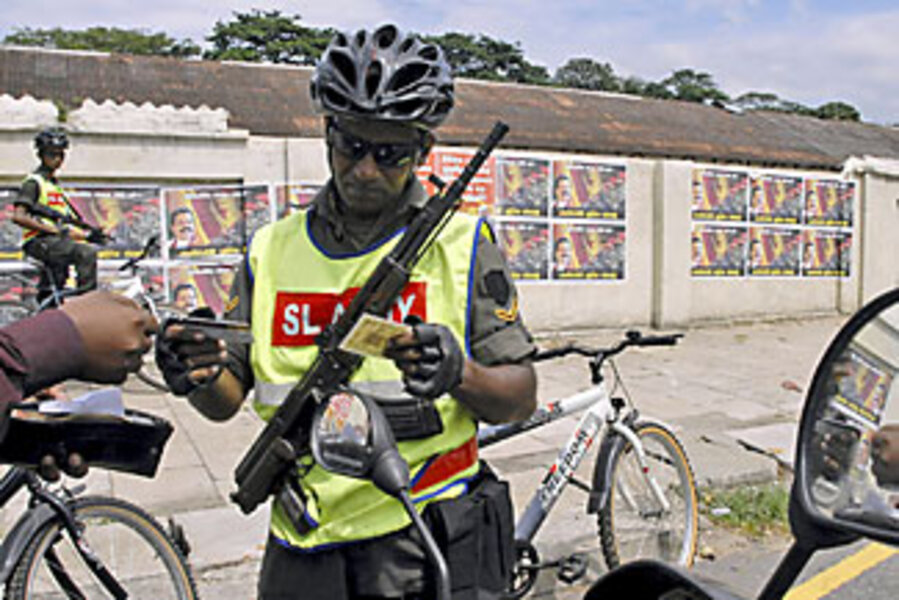Sri Lanka closes in on last rebel stronghold
Loading...
| COLOMBO, SRI LANKA
A foiled suicide attack by two rebel aircraft shook this seaside capital Friday, bringing what should be the final phase of a grinding civil war closer to home.
But the latest show of defiance by the Liberation Tigers of Tamil Eelam (LTTE) has done little to change the facts on the ground in the north, where their dwindling forces are cornered and outgunned. Having overrun several rebel towns and bases, Sri Lankan troops are now pressing into a narrow strip of land on the northeast coast where the rebels are holed up.
At least 70,000 civilians trapped by the fighting have become pawns in the military endgame. In recent weeks, international pressure has mounted on the LTTE to allow them to leave. Tens of thousands have already fled the war zone and been put in military-run camps, but aid workers warn of a humanitarian crisis for those left behind unless they can be evacuated.
Uneasy fight to the end
As fears mount of a violent climax to a decisive battle in a 26-year war, few expect the LTTE to run up a white flag. A more likely scenario, say government officials, Western diplomats, and political analysts, is a messy fight to the death. Such an outcome runs the risk, they say, of creating potential martyrs for a future rebellion by minority Tamils, particularly if peace fails to bring justice to the war-torn north.
"Polarization and disaffection among Tamil people is enormous. This lays the seeds for continued conflict," says Jehan Perrera, executive director of the National Peace Council, a nongovernmental group in Colombo.
Government officials warn that the LTTE may turn to urban terrorism if they lose their last territorial stronghold in the Tamil-dominated north. Residents in Colombo, where even short drives already run a gantlet of military and police checkpoints, say they are wary of a return to suicide bombings, an LTTE hallmark.
But Friday's air attacks came as a surprise, particularly as the military had said earlier this month that it had overrun all the LTTE's northern airstrips.
Electricity was cut across the city as antiaircraft batteries fired at the incoming turbo-prop planes, which the military later said had been loaded with explosives and were intended to crash into two Air Force installations.
One downed plane instead ploughed through the 10th floor of a downtown tax office, from where rescuers pulled out mangled strips of metal painted gunmetal gray. Another plane was shot down near an Air Force base north of the city. Both pilots died, as well as two civilians apparently hit by antiaircraft shells. "I don't think it says the Tigers are any stronger on the ground. But it does say they have command and control capacity," says Alan Keenan, an analyst for the International Crisis Group.
Resistance in the east
In another reminder of the shifting threat, suspected LTTE gunmen killed at least 21 villagers in eastern Sri Lanka on Saturday, the Ministry of Defense said. The government declared victory in the east in 2007, but observers say new pockets of resistance may emerge in the aftermath of a defeat in the north.
With independent monitors barred from the area of fighting, there is wide disagreement on the number and fate of civilians there. UN officials last month said around 250,000 people were affected, but government officials say these figures are vastly inflated and have been further reduced by the escape of 36,000 people in recent weeks.
Human Rights Watch estimates that 2,000 people were killed and 5,000 injured in the latest month of fighting, and accused the military of shelling civilian areas, including hospitals. It also condemned the LTTE for shooting and intimidating those who try to leave and for forcibly recruiting children to fight.
Sri Lankan officials have poured scorn on these and other claims of widespread civilian casualties and accused the LTTE of shelling safe zones set up for fleeing civilians. They also say the military has taken care not to rely on heavy guns in populated areas and is taking greater casualties by engaging rebel fighters in close combat. Military officials have refused to release updated casualty lists, however.
UN head of humanitarian relief John Holmes told reporters Saturday at the end of the three-day trip here that he was concerned about the "significant number of people being killed and injured every day"; and urged both sides to exercise restraint. But he refused to be drawn on casualty figures or the discrepancy over the number of displaced people at risk.
UN officials and aid workers say privately that claims of large numbers of civilian deaths from Army bombardments are accurate. Some are also suspicious of the government's insistence on revising down the numbers of those affected, as it may blur any independent attempt in future to account for the missing and dead.
Any negotiated end to the war hinges on Prabakaran, the veteran leader of the Tigers whose personality cult and paranoia have eliminated all rivals. "The leadership is Prabakaran. It's a collective term for one person," says a Western diplomat.
Last month, the Army chief speculated that he had fled the country, but officials believe he is still here. A photo posted over the weekend on pro-rebel websites showed him posing with the two purported pilots of the suicide planes.





